Explore Vientiane - Laos Travel, Asia
Vientiane, the capital of Laos, offers a unique travel experience for those looking to explore a peaceful Southeast Asian city with a deep connection to its cultural roots. Unlike other bustling capitals, Vientiane boasts a serene and laid-back atmosphere, making it a perfect destination for travelers wanting to escape the chaos of more crowded cities. This charming city sits along the Mekong River, offering scenic views, rich history, and a vibrant yet tranquil way of life. As a gateway to exploring Laos, this capital invites you to slow down, immerse in its heritage, and enjoy the local flavors.
Population: Approximately 840,000 in 2023.
Economy: Vientiane's economy is growing steadily, driven by government services, trade, and tourism. Key sectors include agriculture, manufacturing, and construction. The city's strategic location along the Mekong River supports trade with neighboring Thailand and Vietnam.
Landmarks: Famous for the Pha That Luang, Patuxai, and the Buddha Park (or Wat Xieng Khuan).
Laos
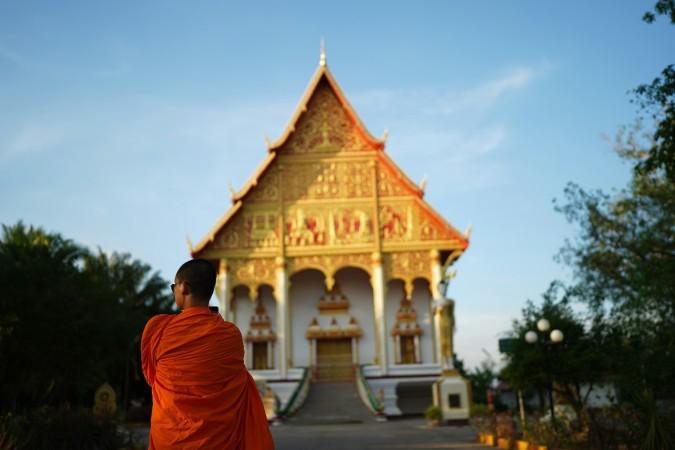
Overview of Vientiane
History & Cultural Influence
Vientiane, the capital of Laos, boasts a rich and complex history that spans centuries. Originally believed to have been a Khmer settlement, the city rose to prominence in 1354 when Fa Ngum founded the Lan Xang kingdom. Despite periods of instability and being destroyed in 1827, the city was later rebuilt during the French colonial era, becoming the capital of French Laos in 1899. Today, Vientiane’s unique blend of French colonial architecture and traditional Lao structures, like the iconic Patuxai Monument and Wat Si Saket, tell the story of its past. The city remains deeply connected to its Theravada Buddhist roots, with numerous temples and daily alms-giving ceremonies still integral to its culture.
Interaction with The Locals
Vientiane, the capital of Laos, has a population of approximately 840.000 people. The city is home to a diverse mix of ethnic groups, with the majority being Lao. The locals are noted for their friendly demeanor and laid-back lifestyle. Vientiane’s citizens have strong ties to their Buddhist traditions, which play a significant role in daily life. Despite being the country's largest city, it maintains a quiet, small-town character, providing tourists with a pleasant and relaxing environment.
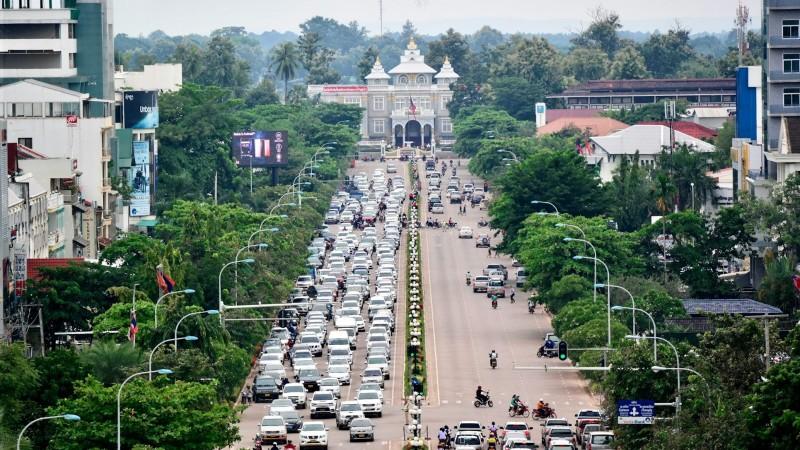
Traffic on a busy street in the center of Vientiane - © Alessio Roversi
Top Attractions in Vientiane
Pha That Luang
Pha That Luang is the most important national monument in Laos, symbolizing both Buddhist values and Lao sovereignty. This stunning golden stupa, originally built in the 16th century, stands 45 meters tall and is adorned with over 500 kilograms of gold leaf. Visitors come to admire its beauty and significance, as it represents a deep connection between Buddhism and Lao identity. Its golden glow, especially at sunset, makes it one of Vientiane’s most iconic sights.
Patuxai
Patuxai, often compared to Paris’ Arc de Triomphe, is a war monument honoring those who fought for Laos’ independence from France. Built between 1957 and 1968, this monument blends traditional Laotian architectural elements with its French influence. Visitors can climb to the top for panoramic views of Vientiane, offering a unique perspective of the city’s skyline and surrounding areas.
Buddha Park (Wat Xieng Khuan)
Buddha Park is a whimsical sculpture garden located just outside Vientiane, featuring more than 200 striking Hindu and Buddhist statues. Despite their ancient appearance, the park was actually built in 1958 by a priest-shaman with a vision of merging the two religious traditions. The highlight for many is the massive reclining Buddha, and visitors can also climb inside a giant pumpkin-shaped structure to explore different levels representing hell, earth, and heaven.
Wat Si Saket
Wat Si Saket is the oldest surviving temple in Vientiane, dating back to 1818. Its unique Siamese architectural style spared it from destruction during the Siamese invasion of 1828. The temple is home to over 2,000 Buddha images, some dating back to the 13th century, making it a must-visit for anyone interested in the religious and historical legacy of Laos.
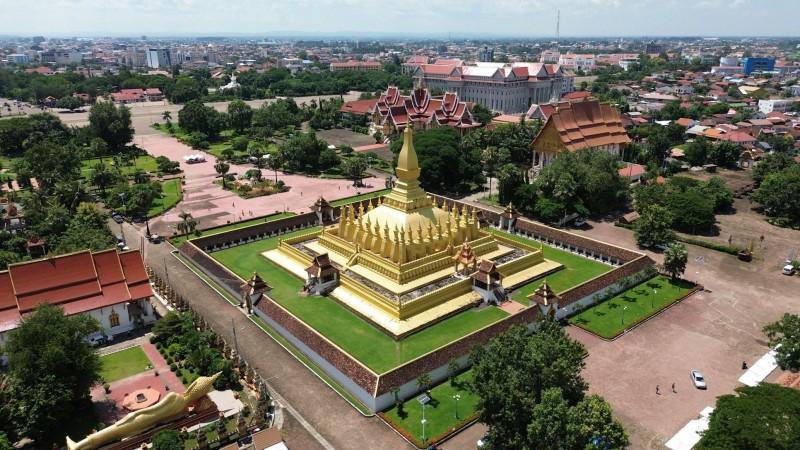
Pha That Luang - © Meklay YOTKHAMSAY
Must-Try Dishes in Vientiane
Vientiane offers a variety of must-try local dishes that capture the essence of Lao cuisine. Be sure to sample all these mouthwatering and unique local delicacies of the region.
- Laap (Meat Salad): This flavorful "meat salad" can be made with pork, chicken, beef, duck, or fish, finely chopped and mixed with lime juice, garlic, fresh herbs, and toasted rice powder.
- Khao Niaw (Sticky Rice): No meal in Vientiane is complete without khao niaw, or sticky rice. Served in small woven baskets, this glutinous rice is traditionally eaten by hand, rolled into small balls, and dipped into various dishes.
- Tam Mak Houng (Papaya Salad): Though it may resemble the Thai version, Tam Mak Houng, or Lao papaya salad, is distinct thanks to its use of padaek, a fermented fish sauce that adds a deeper, more pungent flavor. This dish is all about bold, spicy, and tangy flavors, showcasing the Lao preference for fresh ingredients and a fiery kick.
- Khao Piak Sen (Rice Noodle Soup): This comforting dish is a favorite breakfast option in Vientiane. Khao Piak Sen features soft, wide rice noodles in a rich, flavorful chicken or pork broth, topped with fresh herbs and bean sprouts. The dish reflects the influence of Chinese cuisine on Lao food while offering a unique twist that makes it distinctly Lao.
- Naem Khao (Crispy Coconut Rice Salad): A true Vientiane specialty, Naem Khao is a delightful combination of crispy rice, fermented pork, coconut, and fresh herbs. Typically served with lettuce leaves for wrapping, this dish brings together a perfect mix of textures and flavors, showcasing the Lao culinary tradition of balancing complexity and simplicity in every bite.
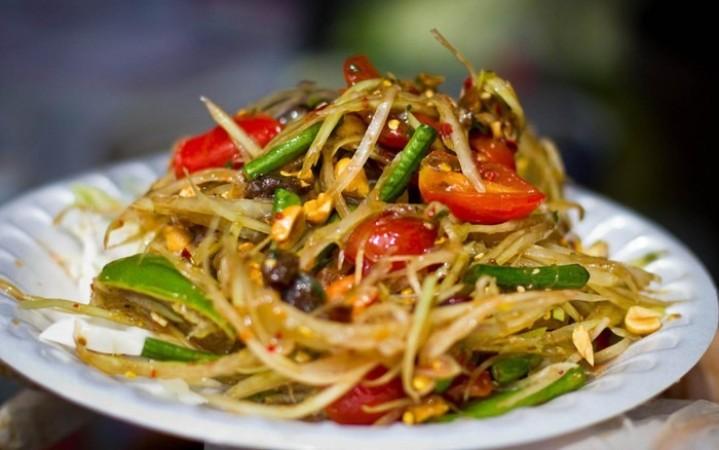
Tam Mak Houng - © Thanhnien News
Festivals & Local Celebrations
Boun Pi Mai (Laos New Year)
Boun Pi Mai is the biggest and most joyful festival in Vientiane and across Laos, held usually during 13-15 April. Expect the city to come alive with water-throwing celebrations, temple visits, and traditional ceremonies. Colorful parades fill the streets, and people engage in the symbolic washing of Buddha images. The festivities also include cultural performances, traditional games, and an energetic, festive atmosphere that stretches over an entire week.
Boun That Luang Festival
Centered around the iconic Pha That Luang stupa, this important Buddhist festival brings together religious and cultural traditions during November. Visitors can experience a grand procession starting from Wat Si Muang, alms-giving to monks, and vibrant cultural performances with traditional music. The festival also features a trade fair with local products and ends with stunning fireworks displays, making it a memorable event.
Boun Awk Phansa (End of Buddhist Lent)
Marking the end of Buddhist Lent in October, this festival brings the city to life with vibrant boat races on the Mekong River. Candlelit processions take place in the evening, and small banana leaf boats adorned with candles and incense are released into the water. Religious ceremonies are held at temples across Vientiane, while music and food stalls create a festive atmosphere throughout the city.
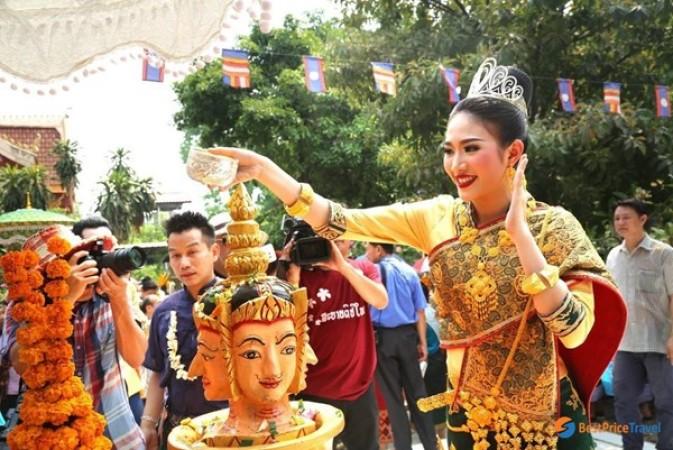
Boun Pi Mai (Laos New Year) - © Bnews
What to Do in Vientiane
- Mekong River Cruises: A sunset cruise along the Mekong River is one of the most relaxing ways to enjoy Vientiane. As the sun sets over the river, you’ll witness stunning views of the city and rural landscapes, all while enjoying the gentle breeze.
- Vientiane Cycling Tours: Vientiane’s flat terrain and relatively quiet streets make it perfect for cycling. Rent a bike and explore hidden streets, local markets, and peaceful temples. You can join guided tours that offer deeper insights into the city's history and culture, with stops at iconic landmarks like Pha That Luang and Patuxai.
- Cultural Tours and Workshops: For those interested in Vientiane’s rich traditions, cultural tours are a must. Visit Wat Si Saket, engage in monk-led meditation sessions, or take part in a cooking class to learn how to prepare traditional Lao dishes like Laap or Khao Poon.
- Spa and Wellness Retreats: Vientiane is also home to various wellness retreats offering traditional Lao massages and spa treatments. After a day of sightseeing, unwind at one of the city’s spas for a relaxing session of herbal therapies, foot massages, or full-body treatments designed to rejuvenate both body and mind.
- Nature and Adventure: Just outside the city, nature lovers can explore Phou Khao Khouay National Park, where trekking, wildlife spotting, and visiting waterfalls are popular activities. For those who enjoy a more leisurely pace, exploring the lush greenery and natural beauty around Vientiane is a great option.
Shopping in Vientiane
- Morning Market: Talat Sao, or the Morning Market, is a bustling hub of activity in Vientiane, open daily from 7:00 AM to 5:00 PM. This lively market offers everything from traditional textiles, jewelry, and handicrafts to fresh produce.
- Vientiane Night Market: Vientiane’s Night Market is a must-visit for anyone wanting to dive into local culture. This vibrant night bazaar is set along the Mekong River, offering stalls filled with clothing, accessories, handicrafts, and local street food.
- Samsenthai Road: Samsenthai Road is one of the city’s main streets, known for its traditional markets and street vendors. It’s perfect for a leisurely stroll, with visitors finding a variety of goods like textiles, jewelry, and Laotian crafts. The street is an excellent destination for those wanting to explore local markets at their own pace.
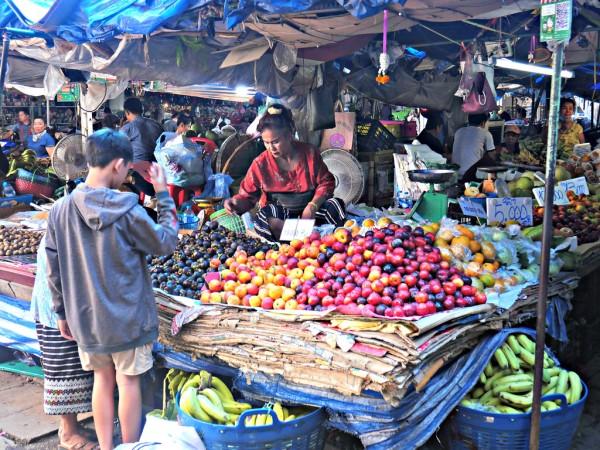
Talat Sao (the Morning Market) - © Flickr (@bindubaba)
Weather in Vientiane: Best Time to Visit
Dry Season in Vientiane
The dry season is the most popular time to visit Vientiane, especially between November and February when the weather is cooler and more comfortable, with temperatures ranging from 20°C to 30°C (68°F to 86°F). These months are ideal for outdoor activities like sightseeing, cycling tours, and exploring the city’s temples and markets. The skies are clear, making it a perfect time for sunset cruises along the Mekong River.
Wet Season in Vientiane
The wet season, from May to October, brings heavy rains and high humidity. Although this period sees fewer tourists, it offers a different perspective of Vientiane’s lush greenery and vibrant landscapes. Rain typically falls in short bursts, usually in the afternoon, leaving the mornings and evenings free for exploration. However, some rural areas may become difficult to access due to flooding, and certain activities, such as hiking, can be more challenging.
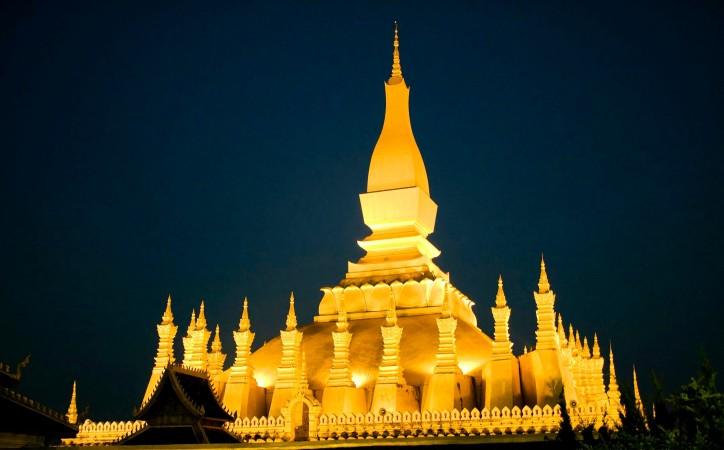
That Luang stupa - © Life on the road
Essential Travel Information
Getting Around Vientiane
- Private Transfer Services: Private transfer services can be booked in advance for a more personalized experience, including meet-and-greet services and flight monitoring.
- Public Transit: While the city's bus network is improving, it is not commonly used by tourists. However, Bus route 14 runs from Talat Sao Market to Buddha Park, and Bus route 29 connects to the Southern Bus Terminal.
- Taxis and Tuk-tuks: Taxis are available but less common than tuk-tuks. Tuk-tuks are widely used for getting around, though tourists may need to negotiate fares, as prices can sometimes be inflated.
- Bicycle Rentals: For a more leisurely and eco-friendly way to explore Vientiane, renting a bicycle is a popular option. Many visitors enjoy cycling through the city’s streets to discover its charms at their own pace.
ATM & Banking Services
Vientiane provides convenient access to ATMs and banking services throughout the city, particularly in tourist areas and near major attractions. Most ATMs accept international cards like Visa and MasterCard, though they often have withdrawal limits and charge small fees for foreign transactions. While the local currency is the Lao Kip, US dollars and Thai baht are also sometimes accepted in larger businesses, but having Kip is essential for smaller, local transactions.
Where to Stay in Vientiane
- Mid-Range Hotels: These options offer modern amenities, personalized service, and a touch of local charm. They provide easy access to cultural landmarks and temples while maintaining a comfortable and welcoming atmosphere.
- Luxury Riverside Hotels: For those seeking a more premium experience, Vientiane boasts luxurious hotels situated along the Mekong River. These accommodations typically offer spacious rooms, fine dining, and wellness facilities, making them perfect for travelers wanting to relax in style. With stunning views of the river, these hotels provide a tranquil escape while still being conveniently close to the city’s attractions.
- Riverside vs. City Center: When choosing where to stay, consider whether you prefer the scenic views and serene environment of the riverside, or the bustling energy of the city center. Riverside hotels offer picturesque sunset views over the Mekong, while staying in the heart of the city provides quick access to markets, restaurants, and cultural sites.
Des articles pour vous

Explore Anuradhapura - Sri Lanka Travel, Asia
Anuradhapura is not just a place to visit, it’s a place to feel. Nestled in Sri Lanka’s North Central Province, this UNESCO World Heritage Site invites travelers to walk among sacred stupas, ancient ruins, and vibrant rituals that span over two millennia. Known as one of the world’s oldest continuously inhabited cities, Anuradhapura blends religious reverence, royal history, and everyday village life. Whether you’re a spiritual seeker, a history lover, or a curious wanderer, this ancient city offers a deep and memorable journey into the heart of Sri Lanka’s cultural identity.
Population: Approximately 950,000 in 2022.
Economy: Anuradhapura’s economy is primarily driven by agriculture, religious tourism, and small-scale trade. The region is known for rice farming, supported by ancient irrigation systems. Tourism, linked to its UNESCO World Heritage status, also plays a vital role, in supporting local businesses, guides, and hospitality services.
Landmarks: Famous for the Sri Maha Bodhi Tree, Ruwanwelisaya Stupa, and Jetavanaramaya Monastery.

Explore Polonnaruwa - Sri Lanka Travel, Asia
Polonnaruwa isn’t just a place but a journey back in time. Tucked in the heart of Sri Lanka’s Cultural Triangle, this UNESCO World Heritage Site is a wonderland of ancient ruins, sacred temples, and royal architecture that whisper tales of a grand past. Once a thriving capital of Sinhalese kings and a center of Buddhist learning, Polonnaruwa today blends history, serenity, and cultural charm. Explore majestic stone carvings, cycle through peaceful landscapes, and connect with locals who embody Sri Lanka’s warm spirit. With every step, you'll uncover layers of a story that spans centuries.
Population: Approximately 450,000 in 2022.
Economy: Polonnaruwa’s economy is primarily driven by agriculture, especially rice cultivation, supported by ancient irrigation systems like Parakrama Samudra. Tourism also plays a key role, with small-scale trading, handicrafts, and local services contributing to the town’s economic fabric.
Landmarks: Famous for the Gal Vihara, Parakrama Samudra, and The Royal Palace of King Parakramabahu I.

Explore Dambulla - Sri Lanka Travel, Asia
Tucked away in Sri Lanka’s Central Province, Dambulla is more than a stopover—it’s a window into the island’s spiritual soul. This town is best known for the Dambulla Cave Temple, a UNESCO World Heritage Site that guards over two millennia of Buddhist art and devotion. But beyond its famed rock shrines lies a land of rolling hills, vibrant markets, and friendly locals. Just a short drive from Sigiriya Rock Fortress and the Cultural Triangle, it’s the perfect base to explore the heart of Sri Lanka.
Population: Approximately 72,000 in 2022.
Economy: Dambulla’s economy thrives on agriculture, tourism, and trade as a major hub in Sri Lanka’s vegetable and fruit supply chain. Tourism also plays a key role in local crafts, hospitality, and transport services, further supporting the regional economy.
Landmarks: Famous for the Dambulla Cave Temple, Sigiriya Rock Fortress, and The Dambulla Dedicated Economic Centre.

Voyage à Kampong Cham - Cambodge, Asie
Kampong Cham est une charmante ville riveraine située le long du fleuve Mékong. Connue pour son importance historique et ses attractions culturelles, Kampong Cham offre un mélange d'architecture coloniale, de temples anciens et de paysages pittoresques. Kampong Cham est reliée au district voisin de Tbong Khmum par le pont Kizuna, le premier pont au Cambodge à traverser le fleuve Mékong, en faisant un carrefour de transport crucial pour la région.
Population : Estimation de 80 000 habitants (en 2024)
Économie : Bien que n'étant pas encore une destination touristique majeure, Kampong Cham propose des sites culturels et historiques, tels que le temple Wat Nokor et le pont en bambou de Koh Pen, ainsi que des attractions naturelles comme des forêts et des chutes d'eau. Le gouvernement se concentre sur le développement du tourisme pour améliorer l'économie locale.
Points d'intérêt : Wat Nokor Bachey, Phnom Han Chey, Phnom Pros et Phnom Srey, pont en bambou de Koh Pen, Wat Joy T'maw, Preah Theat Teuk Chha, piste d'atterrissage abandonnée de l'US.

Explorez Nha Trang - Voyage au centre du Vietnam, Asie
Nichée le long de la magnifique côte du Vietnam, Nha Trang se distingue comme une destination de premier choix pour les voyageurs. Cette ville côtière, réputée pour ses superbes plages et sa vie marine foisonnante, s'adresse à tous. Nha Trang vous accueille à bras ouverts, que vous recherchiez des aventures, de la culture ou de la détente au bord de la mer. Ce guide vous fera découvrir les points forts de cet endroit magnifique, facilitant ainsi la planification de votre voyage de manière fluide et excitante.
Population : Environ 423 000 habitants en 2019.
Économie : L'un des principaux centres touristiques du Vietnam et la plus grande économie de la province de Khanh Hoa.
Sites emblématiques : Célèbre pour les tours Cham de Po Nagar, la cathédrale de Nha Trang et l'île Hon Mun.

Voyage à Sihanoukville - Cambodge, Asie
Sihanoukville, une ville côtière du sud-ouest du Cambodge, est la capitale de la province de Preah Sihanouk. Située sur une péninsule le long du golfe de Thaïlande, la ville est bien reliée à Phnom Penh par des autoroutes principales et dispose d'un aéroport international.
La ville abrite le seul port en eau profonde du Cambodge, jouant un rôle crucial dans la logistique et le commerce du pays. Les plages magnifiques de Sihanoukville, telles qu'Ochheuteal et Serendipity, attirent aussi bien les touristes nationaux qu'internationaux. Le développement économique a prospéré ces dernières années, en particulier grâce à la création de la Zone économique spéciale de Sihanoukville (SSEZ) et aux investissements chinois dans les casinos, l'immobilier et les stations balnéaires. La ville offre également des attractions naturelles telles que le parc national de Ream et plusieurs îles voisines, en faisant une destination variée pour les voyageurs d'affaires et de loisirs.
Population : La population de Sihanoukville était d'environ 160 000 habitants en 2024.
Économie : Sihanoukville, une ville côtière en pleine croissance au Cambodge, se distingue par son mélange dynamique de développement économique et de tourisme. La Zone économique spéciale de Sihanoukville (SSEZ) est devenue un pôle industriel majeur, abritant plus de 180 entreprises et créant des milliers d'emplois. Avec le seul port en eau profonde du Cambodge, la ville joue un rôle clé dans le commerce et la logistique du pays. Bien qu'elle se soit transformée d'une petite ville balnéaire tranquille en un centre urbain animé, Sihanoukville reste célèbre pour ses plages immaculées, attirant des touristes tout au long de l'année. Les investissements chinois importants ont alimenté la croissance des hôtels, des casinos et de l'immobilier, faisant de la ville un centre d'opportunités économiques et d'hospitalité.
Monuments : Plage d'Otres, Plage d'Ochheuteal, Plage de l'Indépendance, Parc national de Ream, Chute d'eau de Kbal Chhay, Monument des Lions d'Or, Wat Leu.
